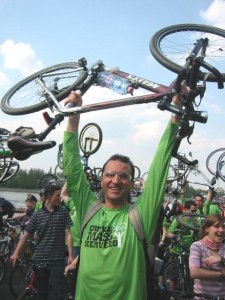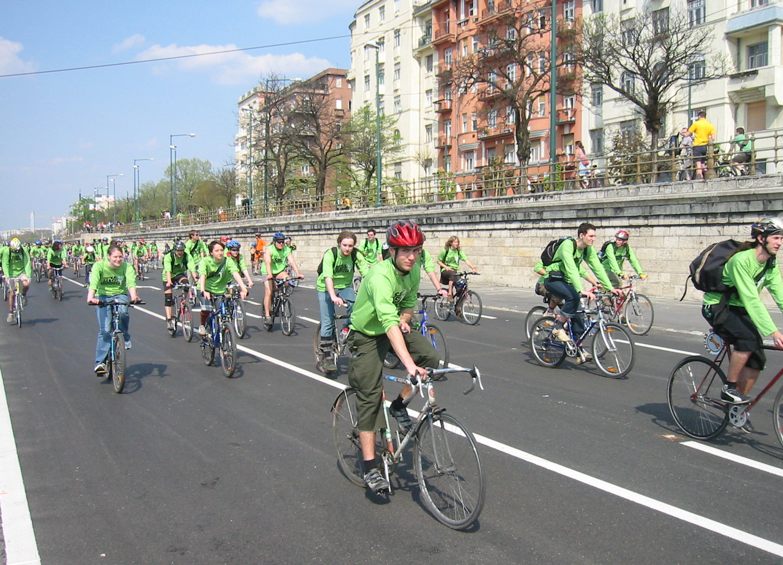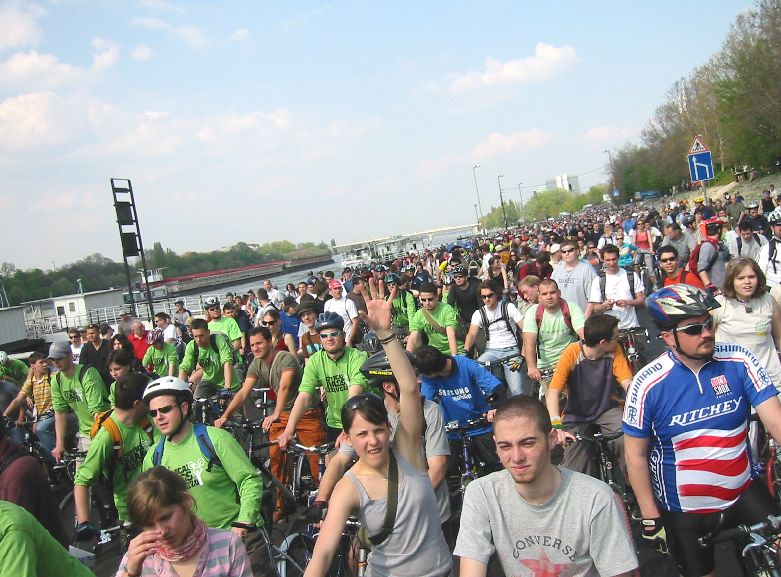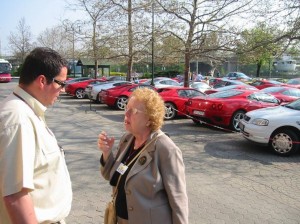Here’s some video of the Budapest Critical Mass ride that Joel wrote about last week. One of these years I will make it over there to see it for myself!
What is Critical Mass?
Critical Mass is a mass bicycle ride that takes place on the last Friday of each month in cities around the world. Everyone is invited! No one is in charge! Bring your bike!
Next San Francisco Critical Mass: July 25th, 2025, 5:30pm, at Embarcadero Plaza (foot of Market Street).
Video of the Budapest Critical Mass
November 18th, 2009 by hughillustration
Optimism is Hard Work: An Ex-Masser Speaks Out
November 18th, 2009 by hughillustrationThis post was sent to me by a friend who no longer rides on Critical Mass:
Critical Mass is at its best an expression of optimism. It’s exuberant. It’s inclusive to riders and non-riders. It’s fun, it’s raucous, it’s irrepressible, it’s uplifting. We aren’t waiting for later, we are making the world we want to live in, right there in front of everyone, snd all kinds of people want to live in that world with us.
But optimism, like rational thought, diversity, real food, relationships, and everything else worth cultivating, takes work. Few people have done the work of Critical Mass over the last few years. No one wants to do the work anymore, and I think the sheer numbers of new Massers have made it a daunting, if not near-impossible task.
I started going to Critical Mass in 1992. I stopped going a few years ago, for a couple of reasons. I’ve always enjoyed the political marketplace of Justin Herman Plaza before the ride and drinking beer in the park after the ride more than the ride itself. Eventually the ride itself became so unenjoyable – never stopping, repeating routes, unnecessarily clogging intersections, and so on – that I stopped going altogether.
In the 1990’s, I usually made a flyer to pass out each month. I spent a good deal of effort explaining the concept of breaking large rides into more easily managed mini-masses, exhorting us to wait at stoplights, to keep our groups together. I advocated meeting up at a destination to hang out afterwards rather than trying to keep a large group together all night.
I noticed that only when dedicated people flyered and spoke to riders consistently for several months did our efforts make any difference. Passing out a flyer alone is not enough, talking to people alone is not enough. Distracted people stick your flyer in their pocket and read only the next morning. New massers need to know that everyone is responsible for the ride, and talking face to face is the way to demonstrate this.
I often argued in the past that the destination was more important than the route, and I still believe this. If the ride is big enough, it’s much better to break up into small groups and just know that you’ll find your friends at the park afterwards (and yes, this worked perfectly without cell phones). Destinations can be far, like Sausalito, though I’ve always preferred the close-in ones, like the Palace of Fine Arts and Dolores or Precita Parks.
And finally, a word about technology. Yep. It’s an anti-fixie screed. Trying to mass up with a herd of fixie riders in the front is impossible, because fixie riders don’t want to lose their momentum. I do feel that the popularity of fixies degraded the quality of Critical Mass. We now have never-ending masses that are strung out to all ends of the City, because there is a group of relatively fast, constantly moving cyclists at the front of the ride.
There is no question Critical Massers should work to change the ride again. We need to help reduce conflict, reduce disruptions to MUNI, create destinations, increase the awareness of new riders about ways to ride enjoyably. We need to bring back the exuberance, and share it with pedestrians, MUNI riders, and motorists. Interestingly, awareness and public support for cyclists is probably higher than it’s ever been in the history of Critical Mass, and it seems to me that people are finally understanding why we ride together – and that us riding together for years
and years has indeed resulted in a number of positive changes. It would be a pity to waste real public goodwill with testosterone-poisoned conflict and tired, repetitive, confrontative rides.It certainly will take several, perhaps tens or hundreds, of dedicated people working over several months to bring a change in the mass. Is it possible? Is Critical Mass is irretrievable?
— A.S.
Why Is Critical Mass Budapest So Huge?
November 11th, 2009 by Joel PomerantzImagine a Critical Mass so large that it simply can’t begin in only one spot at only one meeting time. Imagine a Critical Mass “ride” with so many participants that nobody actually can ride for the first half hour because it’s too dense and slow as tens of thousands of bicyclists begin to move, walking their bikes, along a major urban highway. What I’m asking you to picture is Critical Mass at its biggest, in Budapest, Hungary.
The ride in Budapest routinely and dramatically surpasses all other Critical Mass ride records for size. Why is that? On the one hand, why is it that the ride is so big? On the other, why aren’t all of them like that, in every large city?
It’s easy to point to some of the superficial causes for CMB’s size: It’s only twice a year. The weather’s mild in April and September. Budapest is a capital city. It’s mostly flat. Bikes have been popular for generations in Hungarian cities. But to get to 40,000 riders and more, there’s clearly more going on.

Budapest Massers, while cooperating with authorities, lift their bikes in the air en masse, a gesture that has come to represent defiance and territorial reclamation in American cities.
Rather than point to all the promotion, civic organizing and volunteer effort that creates the ride (and there’s a lot), I’m most fascinated by the underlying reasons for all that effort. In this article, I’m going to build a hypothesis that the success of the ride is, as elsewhere, largely a reaction to intolerable interaction with cars.
Historically, motorized transportation shifted from railroads to automobiles slowly in most places. The first private automobiles made a nasty reputation for themselves by getting stuck in mud easily, being loud, scaring horses, breaking arms (before the crank starter was replaced with a “self-starter” model), and careening through crowds of pedestrians trying to innocently cross the public thoroughfares. The problem of mud, alone, was at such a level that it influenced habits of etiquette into the 1970s, when I was taught to walk between a lady companion and the curb, so as to protect her from splashing mud.
Let’s compare the American story with the proverbial frog placed into a cool pan of water and slowly boiled before it can know what’s happening clearly enough to jump out of the pan.
Now let’s look at the frog in Budapest. Budapest under the Communists was a place of public trains, buses and streetcars, bicycles and serious pedestrian ways. People shopped on foot, near their homes—even in the new suburbs. Commuters used “tram” streetcars instead of cars. The first subway in the world was built in Budapest.
And, of course, there were cars—but not very many. Only the well-connected and politically-favored could drive with any regularity, and an undercurrent of discomfort existed, reflecting a combination of fear, envy and resentment against power and special privilege, including car use. In 1974, only 80 out of each 1000 people in the population owned cars, and fewer still were using them for commuting. [Data from the Hungarian Institute of Transport Sciences.] Compare that to ownership rates of 480 per 1000 in the U.S. at that time.
When the decade of the 1980s ended with the destruction of the Berlin Wall and the collapse of Soviet control over Eastern Europe, the white-hot culture of the automobile came blazing in. Suddenly the frog felt the heat. Unlike in places where roads had to be slowly paved and extended, an infrastructure capable of supporting high-speed car use was already in place, inviting its use.
The opportunities offered when Communist corruption was replaced with Capitalist corruption (and marketing) were similar to those in the recent U.S. housing scandals when banks were newly allowed to make housing loans even to those unable to afford them. Suddenly in Budapest more than half the adult population made it one of their top priorities to own and use a car. People who could barely afford one bought cars to enhance their business opportunities, and their self-respect in the new eyes of a scorching fast culture. By 2004, the car ownership rate in Budapest was 350 per 1000 residents.
To summarize, the Budapest frog went from cool to hot in a very short time.
And it jumped.
The Budapest Critical Mass is evidence of that leap. A quick look at how Critical Mass is viewed in Hungary gives insight into the confused nature of the politics simmering in reaction to the onslaught of cars and dangerous streets on a large, accelerated scale. When I arrived in April 2006, I saw major promotional materials about the ride in the most unlikely of places, by San Francisco standards.

A contingent of hundreds of route monitors leads the ride. The uniformed volunteers peel off in pairs wherever safety monitors are to be stationed. The streets used for the ride are already closed for the entire day by the police, so Budapest's monitors generally act as a buffer between the ride and pedestrians.
The free tourist booklets advertising hotels and nightlife were promoting it—on the front cover. Full size billboards beside the Danube River were promoting the ride. In the newspaper editorials, party bosses and union leaders from all political lineages were promoting the ride. Recumbent bicyclists were promoting the ride with large sign board trailers.
Needless to say, I had to participate. So I borrowed a bike from my hotel, went out on the street, and flagged down every cyclist I saw. Each had a different answer to the question of when and where Critical Mass Budapest began. This is how I learned that the ride started in multiple places, each contingent setting a time corresponding to how far it was from the official congregation point along the river.
When my section of the ride had gone two miles down the river, across the bridge, and then two more miles back north along the other side, I could easily see the crowd across the river. The official starting point was still thick with contingents just beginning the Critical Mass route. We were told that there were 32,000 riders that day. I don’t doubt it.
What I found, though, was a ride with a balance of celebration and politics that I couldn’t quite calibrate. The ride took over the city, with police cooperation, road closures, official shirts and safety monitors. But I couldn’t find one person who could explain why this outpouring hadn’t yet translated into policy changes suppressing the growth of the automobile. Every ride since has topped 40,000—and yet city officials are still promoting infrastructure for cars, trying to balance it with new bicycle measures.

The ride gets going slowly, because of the extremely dense crowd.
As I’ve seen in my visits to rides from Chapel Hill to New York, from San Francisco to Rochester to Rome, the draw of a city’s Critical Mass seems to correlate directly to the absolute quantity of bicyclist frustration on the streets. If the infrastructure makes bicycling a non-issue, as in Amsterdam, or the overwhelming control by cars suppress bicycling altogether, there is no Critical Mass ride. In locations with a small number of cyclists or very polite automobilists, there is a small ride. Where there is a difficult street experience and a large number of bicyclists, there is guaranteed to be a large Critical Mass. Nowhere do these conditions converge so dramatically as in Budapest.
For a few years now, the Budapest frog has been jumping. As we pass the twentieth anniversary of the end of Communist control in Hungary, when will Budapest’s frog find its way out of a pan that has grown very large?

Tags: Budapest, history, ride photos
Halloween Critical Mass Video
November 5th, 2009 by hughillustrationOur friend Sunny Angulo was out on the Halloween ride with a camera crew, making this short video for VidSF!
Thanks, Sunny!
